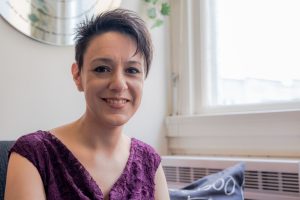
Award winning mathematician and UBC professors, Dr. Stephanie van Willigenburg. The Ubyssey/Koby Michaels
Actua, a Canadian STEM education non-profit, recently released a study about coding education in secondary school. Unsurprisingly and disappointingly, young women were less likely to be interested in computer science. As Actua CEO Jennifer Flanagan explained in an interview with Toronto Star columnist Shree Paradkar, young women were less likely to be interested in computer science not because they were less skilled, but because they were less confident in their abilities. This unfortunate trend is seen across basically all STEM fields and is even more disappointing for women of colour.
The roots of this lack of confidence in STEM has a complex and tangled history. However, opportunities and role models for young women who have an interest in STEM are severely lacking. Although women make up half of the US college-educated workforce, they are vastly underrepresented in STEM fields. Women are consistently not given opportunities to rise in the racks of scientific academia and industry even though they equally qualified for these positions. As you look at the gender breakdown of people enrolled in undergraduate, graduate and Ph.D. degrees, you can see a steady falloff of the number of women. When you get to the level of tenured professors, the numbers are depressingly low.
Former UBC Faculty of Applied Science Associate Dean, Dr. Elizabeth Croft, invites everyone to be an engineer and recounts one of her toughest days as a female engineer. Engineering Stories/YouTube.
These problems aren’t just an American problem, or a few bad-apples problem — they are everywhere and UBC is no exception. UBC’s Faculty of Applied Science is trying to increase the number of women enrolled in engineering program to 50 per cent by the 2020. Today, around 25 per cent of engineering students are female. Only 20 per cent of the faculty’s tenured professors are women.
How can these problems be overcome? Let’s start with a little exercise. Grab a blank piece of paper and a pen. Write down the name of a scientist.
Go ahead, I’ll wait.
Let me guess: you wrote down Albert Einstein, Sir Isaac Newton or Charles Darwin. Or, if you were feeling a little more daring, Alan Turing.
Now write down a female scientists. I’ll wait.
Still waiting.
Yup, still waiting…
How did Dr. Stephanie van Willigenburg overcome prejudice as a female mathematician? She did it by becoming one of the world's best. Engineering Stories/YouTube
I bet it, if you could think of even one, it was Marie Curie. Congratulations. And herein lies a problem.
There are many ways to bridge the gender discrepancy in STEM, but having better representation would go a long way. As a kid fascinated in biology, I imagined myself as Charles Darwin, sailing through the Galapagos, searching for new and undiscovered sequences. I saw myself exploring the cosmos as Carl Sagan and chasing after dinosaur fossils as Dr. Alan Grant. If I had been a young girl, who would I have looked up to?
Giving aspiring scientists someone they can look up to, see themselves as, and reach out to for support would be invaluable in encouraging more women to become scientists.
So, next time you’re telling a story about science, make sure to include a fantastic scientists who just happens to a woman.
Further reading:
The More Gender Equality, the Fewer Women in STEM, The Atlantic, Olga Khazan
I Spent Two Years Trying to Fix the Gender Imbalance in My Stories, The Atlantic, Ed Yong
UBC Student Demographics Breakdown, UBC
Why Are There Still So Few Women in Science?, New York Times, Eileen Pollack
and so, so many more.
UBC professor, BCCDC senior scientist and CBC host Dr. Jennifer Gardy discusses how she became interested in science and how her creativity makes her a better scientist. Engineering Stories/YouTube
– Koby Michaels
